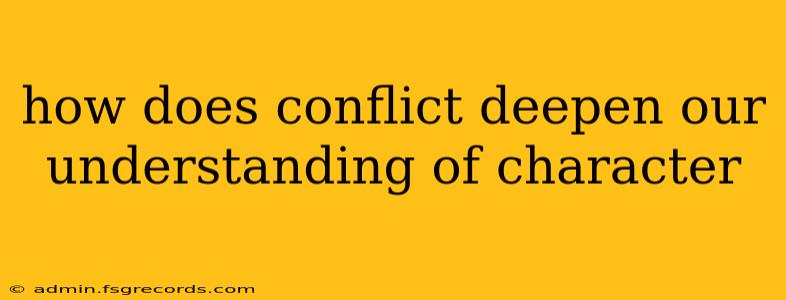Conflict is the very heartbeat of compelling storytelling. It's not just about explosions and sword fights; it's the engine that drives character development and reveals the true depths of human nature. Understanding how conflict functions in narrative is key to appreciating literature, film, and even real-life interactions. This exploration delves into the multifaceted ways conflict deepens our understanding of character, revealing hidden strengths, weaknesses, and motivations.
The Crucible of Conflict: Forging Character Through Challenge
Conflict, in its broadest sense, represents any struggle or opposition a character faces. This can manifest in various forms:
-
Internal Conflict: The character battles inner demons, moral dilemmas, or conflicting desires. This type of conflict reveals a character's values, beliefs, and psychological makeup. Hamlet's internal struggle with revenge, for instance, exposes his indecisiveness and profound melancholy.
-
External Conflict: The character confronts an outside force – another person, nature, society, or fate. This type of conflict reveals how a character reacts under pressure, demonstrating their resilience, resourcefulness, or vulnerability. The protagonist in a survival story facing a harsh wilderness reveals their adaptability and determination.
-
Interpersonal Conflict: This involves disagreements and clashes between characters, unveiling their relationships, motivations, and perspectives. The tension between two rivals in a business negotiation exposes their ambitions and moral compasses.
Revealing Hidden Strengths and Weaknesses
Conflict doesn't just highlight pre-existing traits; it forges new ones. Under pressure, characters reveal aspects of themselves they may not even be aware of. A timid character might unexpectedly display bravery in the face of danger, while a seemingly strong character might crumble under immense stress, revealing vulnerabilities. These revelations are crucial in building a three-dimensional, believable character.
Unmasking Motivations and Desires
Conflict often acts as a catalyst, forcing characters to make choices that expose their deepest motivations and desires. A character's actions during a crisis demonstrate what they truly value: Are they driven by ambition, love, revenge, or survival? Their responses reveal the underlying forces shaping their personality and actions.
Different Types of Conflict and Their Impact
The type of conflict employed also significantly influences our understanding of character.
Man vs. Self: Internal Battles and Self-Discovery
Internal conflict forces introspection and self-discovery. By observing a character wrestling with their inner demons, we gain insights into their moral compass, fears, and aspirations. This often leads to significant personal growth or, conversely, a descent into self-destruction.
Man vs. Man: Relationships and Power Dynamics
Interpersonal conflict illuminates relationships and power dynamics. How a character interacts with others, particularly in conflict, reveals their social skills, empathy, and capacity for compassion or cruelty. The way they resolve (or fail to resolve) conflict sheds light on their personality and maturity.
Man vs. Society: Challenging Norms and Beliefs
Conflicts with societal norms or expectations reveal a character's courage, rebellion, or conformity. A character who challenges the status quo might expose their strong moral convictions or a deep-seated sense of injustice. Conversely, a character who blindly follows societal norms might reveal their lack of independent thought.
Man vs. Nature: Resilience and Adaptability
Conflicts with nature showcase a character's resilience, resourcefulness, and adaptability. Facing extreme conditions reveals their physical and mental strength, their survival instincts, and their ability to overcome adversity.
Conclusion: Conflict as a Catalyst for Growth
In conclusion, conflict is not merely an obstacle in a narrative; it's the crucial catalyst that deepens our understanding of character. Through the challenges they face, both internal and external, characters reveal their true selves—their strengths, weaknesses, motivations, and ultimately, their humanity. By carefully observing how characters respond to conflict, we gain invaluable insights into the complexities of the human condition.

